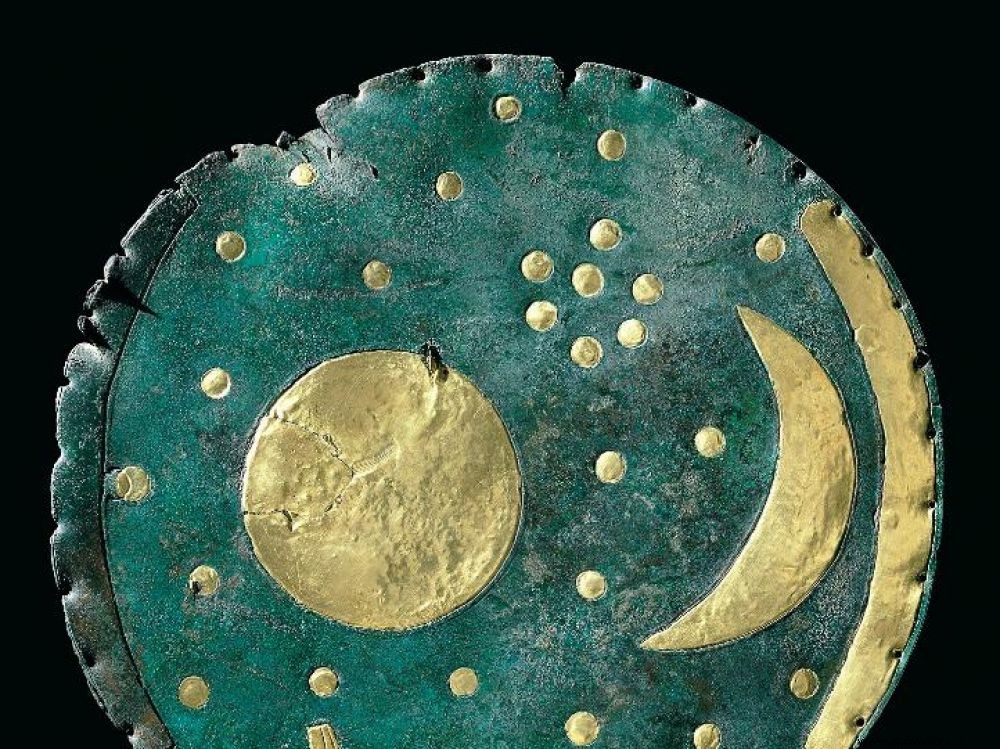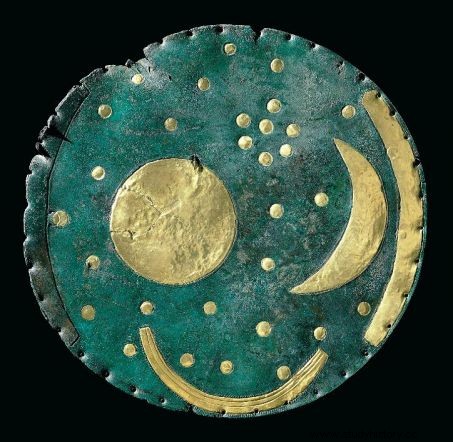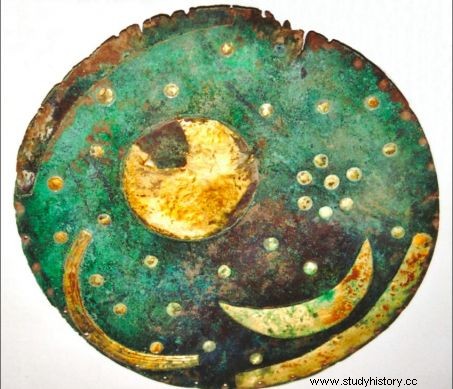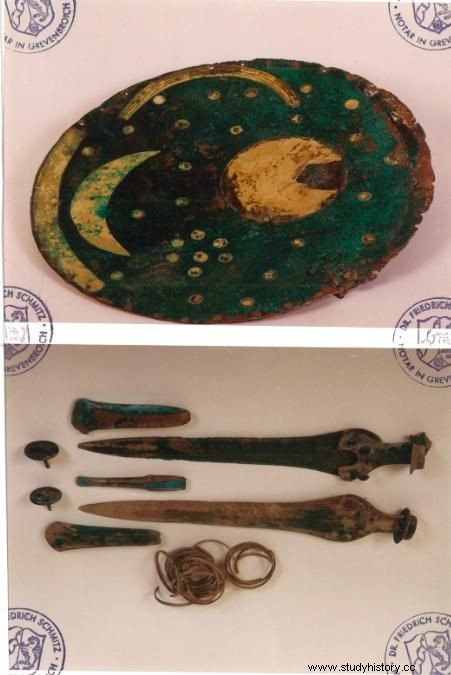Discovered in Germany in 1999, the Nebra Disc, considered until then to be the world's first representation of the celestial vault, would probably not be 3,600 years old, but would be much more recent. According to two archaeologists from Frankfurt and Munich, its origin dates back only to the first millennium BC.

In bronze and gold, the Nebra disc is encrusted with ornaments depicting constellations. It would represent the oldest celestial vault.
"It's a clap of thunder in the sky of protohistory!" , Dominique Garcia, president of the National Institute for Preventive Archaeological Research (Inrap), was not mistaken. It is indeed a bombshell that two German archaeologists have just dropped, publishing the results of a new study in the journal Archäologische Informations on the celestial disc of Nebra, inscribed since 2013 on the UNESCO Memory of the World Register.
UPDATE . In November 2020, new twists in the controversy over the age of the famous Nebra disk:a new scientific publication refutes point by point the work rejuvenating this 1000-year-old object. For its authors, there is no doubt that this archaeological treasure is indeed the oldest representation in the world of the celestial vault.
Until now, the famous metal pancake kept in the museum of Halle (Germany) was considered to date from the beginning of the Bronze Age, and the oldest reproduction of the cosmos in the world (2200-1600 BC). . But by reanalyzing various data on the circumstances of its discovery, Rupert Gebhard, director of the Archaeological Collection of the Munich Archäologischen Staatssammlung and professor of protohistory at the University of Munich, and Rüdiger Krause, professor of prehistory at the Goethe University of Frankfurt, challenge these data:they conclude that the disc belongs rather to the Iron Age, i.e. 1,000 years later (about 800-50 BC), "making obsolete all previous astronomical interpretations" , according to their press release.

The Nebra disk and its constellations. Credits:LDA Sachsen-Anhalt (Photo:Juraj Lipták)
A celestial disc
The Nebra Disc is one of the most important archaeological finds in Europe. With a diameter of 32 cm, this object was unearthed in 1999, near Nebra, north of Leipzig, in eastern Germany. Adorned on one of its faces with gold inlays representing movements of the sky, one can distinguish 32 stars, including the constellation of the Pleiades, a crescent moon, a sun (or a full moon), and elements, on the edge, depicting the horizon and a boat (read Sciences et Avenir n°709 ). It is on the incredible conditions of this find made during an illegal excavation that the discussions partly stumble. For Rupert Gebhard and Rüdiger Krause, the complete analysis of the circumstances of the discovery leads to consider "that there is no convincing evidence that the swords, axes and bracelets of the Bronze Age [supposedly found next to the disk] form a set of common origin" . In essence, the disc and the swords would not come from the same place. For them, if the weapons and bracelets were well brought together in a deposit of the Bronze Age, the disc would have been flushed out on the mount of Mittelberg, but in another deposit, later in age. Which would explain, according to the two authors, why "cculturally and stylistically" , the celestial disc motifs do not belong to the Bronze Age universe, but rather refer to Iron Age themes of the first millennium BC. For these specialists, all historical-cultural conclusions and previous interpretations of the celestial disc, should therefore be discussed again.

The Nebra disk at the time of its recovery, before the restoration work carried out at the Landesmuseum Halle. Credits:Photo:Hildegard Burri-Bayer
Joined by Sciences et Avenir , archaeologist Harald Meller, who has participated in all work on this object since its discovery, did not fail to react to these statements. "The Nebra Disk has been the subject of intensive research for many years by many scientists in a wide range of fields. The authors, who now question its age, have only eclecticly considered literature relating to the disc. It is impossible for me to cover here in one word all the inconsistencies of their article" . The archaeologist from Halle thus recalls that analyzes had been carried out in 2008 and 2010 by the famous Austrian archaeometallurgist Ernst Pernicka, who with his colleagues concluded that the copper present in all the pieces of the deposit (swords as much as discs) came from from the same deposit. Furthermore, "analysis of Celtic copper alloys [the later Iron Age ones]show completely different compositions that do not match the Nebra Disc alloys" . Conversely , for the protohistorian Patrice Brun, professor emeritus at the University of Paris I-Panthéon-Sorbonne, the article by Rupert Gebhard and Rüdiger Krause deserves to raise legitimate questions about the true origin of the famous disc that we cannot sweep with the back of the hand. This is still going to cause a lot of ink to flow.
An incredible discovery
Unearthed in the summer of 1999 by two treasure looters equipped with a metal detector in the Mittelberg mountain (Saxony-Anhalt, Germany), the Nebra disc would have (since it is now disputed) been exhumed with swords, bracelets and some other metal utensils stacked on top of each other. Having only a vague idea of the value of their loot, the two looters immediately sought to sell it. In the spring of 2001, the treasure was thus offered to the directors of the museums of Munich and Berlin for the amount of half a million euros...

Circa January 2002, after authorities recovered the Bronze Age swords, axes and bracelets, which were allegedly found with the Nebra Disc. Credits:Hildegard Burri-Bayer
Taking fright at the reaction of specialists who wonder about the origin of such remains, the looters were immediately forgotten. Alerted by the director of the Berlin museum – who has kept the photos of the objects offered -, Harald Meller, director of the Halle Museum, then goes on the hunt to try to find the trace of the loot. What he manages to do after several months of investigations after he posed as a potential buyer. He then alerted the police who set an ambush in a restaurant in Basel (Switzerland), to find the flagrante delicto at the time of the transaction. Subsequently, the looters will lead the archaeologists to the scene of their crime. After analysis of the remains of sediment taken from the disc and from the malachite (copper carbonate) corrosion from the deposit from which the remains come, the forensic science of the Land of Brandenburg establishes that the geographical origin of the disc and the deposit is indeed the same. Later, radiocarbon dating carried out on birch fragments discovered in the handle of one of the two swords revealed that the set is at least 3,600 years old and probably comes from a votive deposit.
